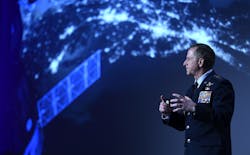Communications methods and equipment have become even more complicated on the battlefield than in everyday life, and the importance of properly orchestrating multidomain command and control (C2) was emphasized recently at a meeting of top U.S. Air Force leaders. Chief of Staff General David L. Goldfein (see photo) and others challenged industry partners to be well aware of the challenges of maintaining C2 across ever-changing technologies, and to be prepared to quickly develop advanced solutions.
Goldfein and the others were addressing attendees at the Air Force Association (AFA) Air Warfare Symposium—an event focused on technology fusion—held in Orlando March 2. He spoke with optimism about not only keeping pace with the latest technologies, but staying ahead of technologies as applied by adversaries.
Goldfein referred to the need for a new way of thinking about C2 and how it can be performed most effectively. “If you think about multi-domain C2 as a place, you’re already too limited,” he said. “If you start thinking about it as a bunch of computer screens in a place, you’re already too narrow. It’s a [concept of operations], it’s a way of thinking.”
At the same AFA event, General Hawk Carlisle, commander of Air Combat Command (ACC), explained that the USAF must combine C2 capabilities with fusion systems so that information can be most effective processes and communicated on the battlefield. “If you want to get combat ID, if you want to get weapons quality track, you have to get to fusion warfare,” he said.
As Carlisle pointed out, the concept integrates information from many sources. “It’s not just data—when you talk fusion with multiple sensors across battlespace, you have to get into the mechanics of how the sensors work,” he explained. “You have to get into the algorithms, so that multiple pieces of data can fuse at a level that gives you combat ID. That fusion is hard...but that’s where we’re trying to get to.”
About the Author
Jack Browne
Technical Contributor
Jack Browne, Technical Contributor, has worked in technical publishing for over 30 years. He managed the content and production of three technical journals while at the American Institute of Physics, including Medical Physics and the Journal of Vacuum Science & Technology. He has been a Publisher and Editor for Penton Media, started the firm’s Wireless Symposium & Exhibition trade show in 1993, and currently serves as Technical Contributor for that company's Microwaves & RF magazine. Browne, who holds a BS in Mathematics from City College of New York and BA degrees in English and Philosophy from Fordham University, is a member of the IEEE.

